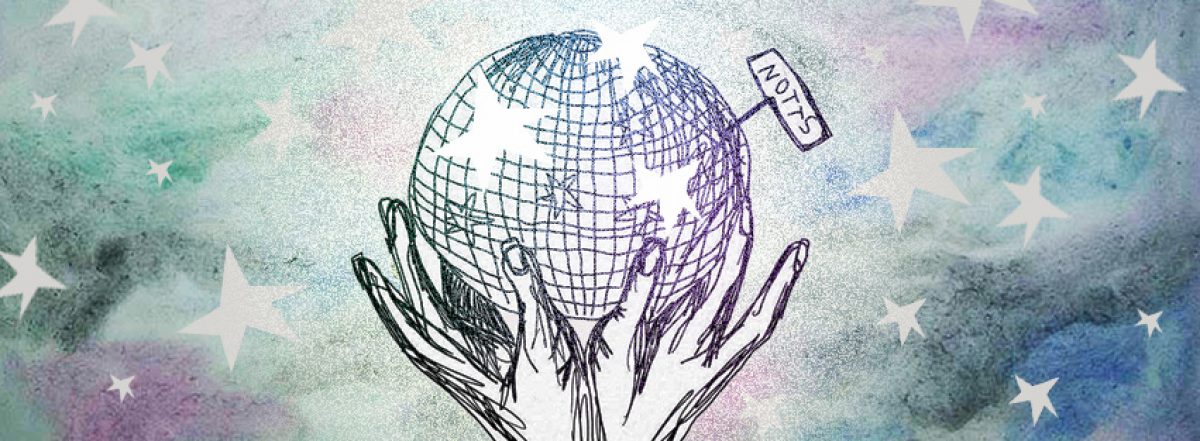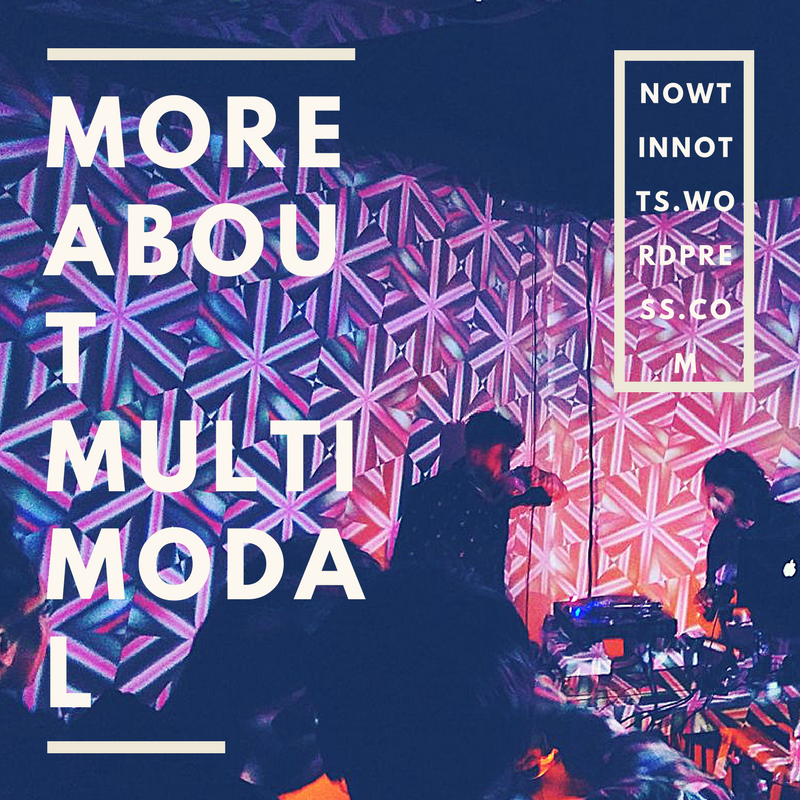Back in January, I heard about a new night / experiment that was coming to Notts and started to anticipate the details. This night was Multimodal.
Since then, we know a lot more about the night such as the venue (One Thoresby Street) the date (This Saturday, 8th April) and what to expect (a 5 hour live A/V performance, with founder Matt Woodham taking care of the visuals while Lukas Wigflex sets the sonic scene) however, there still remains a lot of mystery about Multimodal.
It’s clear that I wasn’t the only one intrigued by this announcement, with tickets selling out well in advance. But maybe due to its newness or simply its unfathomable concept, there is only one person who can explain exactly what Multimodal is all about.
Here, I spoke to Matt about his new project:
It sold out very quickly and this is your first event! Did you think it would be as popular as that?
Not at all! It’s so hard to predict these things. I kept the prices low and the format as simple as possible as I was worried nobody would be interested. I was totally amazed by people’s response, I definitely think it helps having Lukas (Wigflex) involved with the project. His knowledge and esteem definitely got the event out to the right people.
How many more will you be doing?
There will be many more if all goes to plan. This specific performance will hopefully tour around a few venues. As it sold out so fast there’s a possibility I’ll use One Thoresby Street again to allow those who missed out to catch it in this incarnation. It’s also nice bringing people into my studio building as well. In the meantime, I’ll be doing a few more events which push the concept of the events further in somethings quite different. I’m planning to perform an AV experiment on the audience in a participatory installation – gathering data which will inform a visual neuroscience study in the future.
Why do you think it’s struck a chord with so many people?
It’s hard to say really. I’d love to think that people have an interest in the concept behind Multimodal and the theory of the event, although I feel it’s more likely that people are just looking for something a bit different. A unique experience with a bunch of visuals does seem to grab people’s attention quite well. Regardless of the motives I’m just happy for people to turn up and engage with any aspect of the event. My plan with Multimodal is for it to be a bit of a Trojan horse – keeping it accessible to all but with an extra layer of theory.
Since my initial post, the secret is out and many of my questions have been answered, such as where the event will be. Why One Thoresby Street?
That’s a simple one – as my studio is next door to the event space, I know it very well. The size of the Attic is perfect for testing the waters with my first event. An added bonus is that there are large white walls which are great to project onto.
Which space will it be in? The smaller, upstairs studio or the downstairs hall (or is this still kept under wraps?)
It’s in the Attic gallery, there hasn’t been an event here in a good while so it’ll be great to have people dancing up there again!
The performance is 10pm – 2am. What can we expect for the rest of the night?
Doors at 9pm and we’ll slowly ease people into the visuals from 10pm. It can be quite full-on so we just thought we’d start slow. From 9-10pm will be mainly ambient music.
Will you pre-create or design visuals that then react to the sounds, or will they be totally generated on the night?
The visuals are generated live, in response to the music Lukas is playing. I’ve designed a custom controller to adjust specific parameters of the patterns such as spatial frequency, colour, spacing, width, angle, tiling parameters etc. The visuals are automatically kept in sync with the music, it’s just up to me and Lukas to create a performance together on the night!
What level of control will you have over the appearance of the visuals?
Pretty much complete control. I’ve designed the controller in two halves, each controlling one of the two layers. As each layer is generated from an extremely simple pattern with only a few parameters to adjust, it’s the specific interaction between the two layers which causes the intense, shifting geometry.
What kind of sounds can we expect while the performance is on? Will Lukas perform these?
As I mentioned earlier, we’ll start slow, with ambience and soundscapes, slowly building and increasing tempo towards the end of the night. If you’re familiar with Lukas’ sets, expect to hear his more experimental side.
Please explain “the computational processes involved in the summation of sinusoidal grating responses” or simply, tell us more about the research behind this project!
The research behind the project is from an electroencephalogram (EEG) study I conducted for my dissertation at the University of Nottingham. The study was attempting to uncover the mechanisms of ‘mid-level’ vision.
While much is known about both ‘low-level’ vision, early in the cortical visual processing hierarchy, and ‘high-level’ vision in the later semantic processing of vision, the intermediary stage remains a mystery at this point. As we know that single neurons selectively respond to sinusoidal gratings with a specific orientation and spatial frequency, the next step is to understand how the brain processes combined grating patters, or ‘plaids’. Current visual neuroscience is attempting to understand how the neural signals are combined to create the visual experience of perception, although many see the task as challenging due to the large degree of complexity.
Is this research something you are doing yourself or is it part of a wider study?
It’s part of wider research on mid-level vision lead by Prof. Jon Peirce at the University of Nottingham. I’ve been keeping in touch with Jon since graduating and following the progress of the research. The experimental method has evolved in some very interesting ways since I’ve graduated. Future events will explore this new method a bit deeper and I’m hoping to collaborate with Jon to figure out how we might present this.
Tell us more about your background – I know you practice the visual arts but are obviously involved in science too. What role do both of these disciplines play in your educational/professional life?
I graduated in 2014 studying Psychology & Cognitive Neuroscience at The University of Nottingham, specialising in visual neuroscience. Since then I’ve been working freelance on various projects, while continuing my experimental audio-visual practice. I try to combine my interest in arts, science and technology as much as possible with my practice.
I created Multimodal as a platform for the intersection between these disciplines – creating engaging experiences for the public but also continuing my research. I’m currently applying for funding for Multimodal which will enable new research to be conducted. I’ve recently been focusing on Complexity Science which combines many areas of my interest, so future Multimodal events will be exploring specific themes of complexity a bit deeper.
“This simple pattern is combined and processed through the visual pathway with Fourier-like principles to create our complex visual experience contributing to our overall perception.” – could the visuals you create mimic the ‘visuals’ that are produced in our brains when processing sensory information?
Yep exactly.
The visuals aim to represent the computational processing of the simple sinusoidal grating stimuli, while also directly stimulating these early-mid regions. When playing around with the idea using the same patterns as my EEG study within my visual software I was immediately struck by the vast increase in complexity with just a few simple transformations of 2 combined layers. My hope is that this emergent behaviour is clear – while the patterns are incredibly basic, the viewing experience certainly doesn’t feel that way!
You talk about creating a new layer of perceptual experience. Can you even being to describe what this might be, or is it one to leave for the night?
The new layer, which wasn’t present in my EEG study, is the introduction of music. Auditory and visual stimuli interact within the brain, with perception erring to the sense which is most likely to be ‘true’ in a given circumstance.
This ‘Multisensory (or Multimodal) Integration’ gives rise to a number of perceptual illusions. Understanding the mechanisms behind them might allow us to understand why AV experiences often seem to have an element of ‘magic’ to them. Once again, these ideas will be explored in future events!
What was the spark that generated the idea for Multimodal?
While I’ve been working for a few years performing visuals and building installations for events, I’ve not been able to explore ideas or themes related to my research and interest in science and technology. These are ultimately the projects I want to work on, so I had to build a platform for them. I’m just super happy that people seem interested so far! I’d be extremely grateful to continue exploring these ideas while making experiences for people to enjoy and learn from.
Multimodal will stage its first performance on Saturday 8th April at One Thoresby Street.
Tickets are sold out – but more nights are sure to come.
Get a sneak peak of what to expect in this video.

